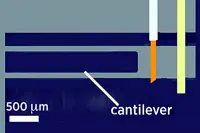 The atomic force microscope (AFM) is used by scientists to resolve features as small as individual atoms. Instead of magnifying with a lens, AFMs use a flexible cantilever with a tiny tip to 'feel' the surface. As a nanoscale feature is passed, interactions between the atoms on the tip and on the object's surface cause the cantilever to bend, revealing the finest of details.
The atomic force microscope (AFM) is used by scientists to resolve features as small as individual atoms. Instead of magnifying with a lens, AFMs use a flexible cantilever with a tiny tip to 'feel' the surface. As a nanoscale feature is passed, interactions between the atoms on the tip and on the object's surface cause the cantilever to bend, revealing the finest of details.
Scientists have increased AFM sensitivity by making the tip vibrate at a particular frequency as it passes over the surface and measuring how much the frequency changes. This is because frequency can be measured more precisely than many other parameters.
However, calibrating the tip is an issue. Because AFMs operate in a near vacuum at temperatures approaching absolute zero, the tip and the specimen interact in a tight space behind several walls. In order to calibrate the tip, it has to be removed and checked at room temperature. This not only skews AFM results but also requires exotic calibration equipment.
Looking to sidestep such problems, scientists at the US National Institute of Standards and Technology (NIST) have developed a sensor that promises to increase AFM accuracy.
"With our sensor," says NIST's Gordon Shaw, "the tools you need to calibrate the tip are built right into the sensor, so it would not need to be removed from the AFM."
The sensor is a redesign of the device that makes the tip vibrate. Made of a silicate material, the cantilever is roughly 3mm long, with a mirror at the end that reflects light from an LED. The LED delivers a specific amount of energy and when the photons strike the mirror, they exert enough pressure to set the cantilever vibrating. The distance the tip travels upwards and downwards is said to be the critical figure needed to equate a change in the tip's frequency to a change in atomic force.
"The sensor is capable of resolving forces as small as femto Newtons," said Shaw. "It gives us a useful reference, which is hard to come by when you're working with such tiny forces."
Author
Graham Pitcher
Source: www.newelectronics.co.uk
